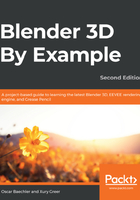
上QQ阅读APP看书,第一时间看更新
Chair 5 – wooden layers with Booleans
This geometric chair is manufactured out of sequential layers of cut wooden panels, which are then bound together. We'll make this in Blender by combining two objects with Boolean modifiers. We'll use one object for the overall chair shape, another object for the repeating wooden layers, and Boolean modifiers to cut the chair from the wood.
We will perform the following steps:
- The initial "cage" of our chair will provide the overall shape that cuts out the wooden slats. Add a Plane object and scale it on the floor to the length and width of a chair. Extrude a front edge up, then back, then up again for a curving, spring-based chair back.
- Add a Mirror modifier, then with the three-dimensional cursor set to the world origin, scale the left verts to 0 for the line of symmetry. Extrude an arm up as well.
- Add a Solidify modifier and set the Solidify modifier's thickness to -.1. Add a Subdivision surface modifier set to 3 subdivisions and soften the overall mesh with a Smooth modifier set to a factor of 1 and a repeat of 5. Add edge loops and organic modeling choices and adjust the subsurface's edge crease on individual edges with Ctrl + E.
- This "cage" will only be used to slice our chair, so in its object properties, go to Viewport Display and set Display As to Wire. Despite only using eight polygons, the modifier stack gives this chair an appealing form, as you can see here:

Our cage set to Display As Wire
- Next, we'll create our wooden slats. Create a plane mesh, then add an Array modifier with a count of 50 and a constant offset of Z = .02.
- Add a Boolean modifier, change its operation to Intersect, and choose your chair cage as the object. This modifier stack effectively creates a cube of planes, then cuts them into a chair shape.
- Add a Solidify modifier with a thickness of .019, just slightly less than the array distance.
- Finally, in the object's properties, turn on auto smooth. This "cube" can now be moved and rotated for a variety of cut looks. An angle of 90 degrees on the y-axis makes straight planes against each other, but a more organic diagonal rotation has a dynamic appeal.
- As a final adjustment, use a second Boolean object to make the bottom of our chair flat. Add a cube, then on your arrayed plane object, add another Boolean modifier, set to Subtract, and set the new cube as the object. Move its top plane down to the z-axis, slicing away to make our chair flush to the ground.
That should do it! Our example turned out like this:

A beautiful final chair for our kitchen scene
Just like we did with the tables, we need to place each chair in its own collection, called chair01, chair02, chair03, and so on. Good organization is vital for the important parts of complex scenes. Once you've got each chair in a collection, we can link them back to the kitchen scene.